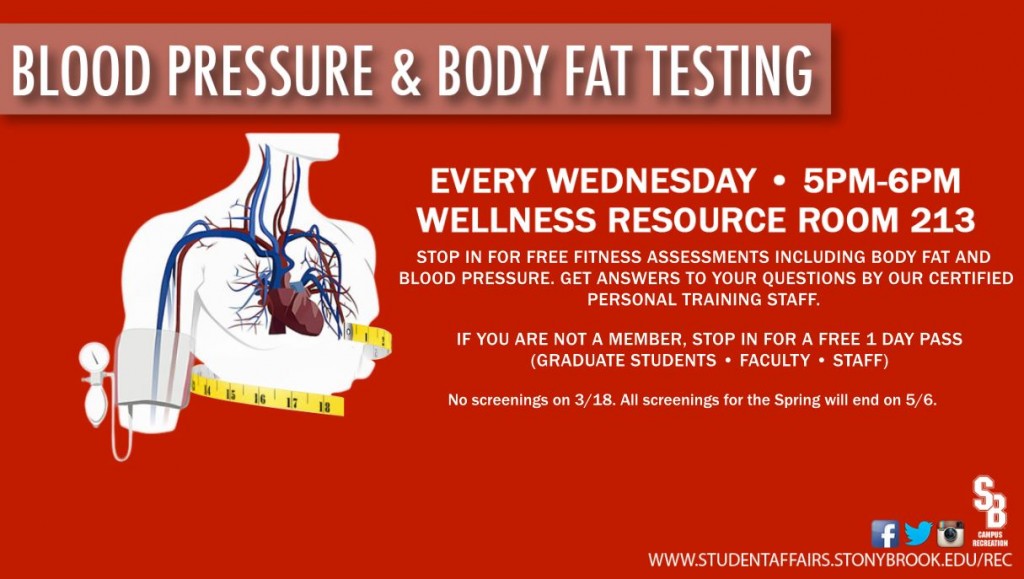 More Importantly… Remember to follow everything with moderation.
More Importantly… Remember to follow everything with moderation.
Category Archives: Wellness
Motivational Monday
Fitness Friday
Working Out From Home? No Problem!
Try out these quick and easy workouts to get a head start on the day.
Wellness Wednesday
Motivational Monday
Blood Pressure & Body Fat Testing
Looking To Spring Back Into Fitness?
Start Slowly
When returning to exercise after a prolonged absence, remember to start slowly. You can return to the same exercise you previously did, but at a lower intensity. For example, if you were a runner, return by starting with walking and building through a jog to a run. If you previously did weight training, reduce weights to around half of the weight you lifted before your break. Aim to work out two to three times per week and keep sessions less than 45 minutes for the first two to four weeks. Extend your warm-up and cool down to protect muscles and joints from injury. As your fitness builds, usually around the six-week mark, you can add more workouts per week and increase the time spent working out. You will know you are ready to progress when your workout routine is no longer challenging.
Enjoy It
The number one reason people give up exercise is boredom. When choosing an activity to ease back into shape, choose one that you will enjoy and even look forward to. Find a friend to work out with you. You can keep each other accountable and on track. If you have a dog, consider daily walks — it’s good for both of you. Another way to enjoy working out is to catch up on your favorite television shows or read a good book while on the treadmill or stationary bike. Varying your routine and alternating activities can also keep your workout session fresh and exciting.
Be Patient
It will take time to build yourself back to the level of fitness you were at before your break, so don’t expect too much too soon. Your body is adaptive and will usually return to normal after six weeks of modified exercise. Resist the urge to push yourself in the beginning. Trust your body’s signals, such as fatigue, to let you know when you have reached your limit for each session. Do not wait until you are in pain to stop. Stop when you feel your muscles tiring. Pushing yourself can result in an injury, which will force you to again take time out from your workout routine.
Set A Fitness Goal
Sit down and figure out a goal you want to achieve. Do you want to run 1 mile, or 5? Swim two laps or 20? Climb every mountain, or maybe just that hilly sidewalk in your neighborhood? Write down your goal, and keep it in front of you. The refrigerator is a good place. So is your desk.
Follow A Fitness Plan
 Now figure out the baby steps you’re going to take to get to that goal. Look at how, where, and with whom you spend time, and start to make changes that allow you the time you need to get back in shape.
Now figure out the baby steps you’re going to take to get to that goal. Look at how, where, and with whom you spend time, and start to make changes that allow you the time you need to get back in shape.
Find Alternative Fitness Opportunities
If you’ve been injured and are on the road to recovery, find ways to exercise that begin to rebuild your strength and stamina. You might try elliptical or rowing machines, bicycling, dancing, swimming, or easy hiking. Maybe now is the time to start yoga, or pilates.
Fitness Friday
Working out from home? No Problem!
Try to squeeze in these quick and easy workouts into your busy schedule to get a head start on the day.
Run Seawolves, Run!
We all know that running is a great and easy way to stay in shape, but did you know that you could be making your runs harder on yourself based on how you move? Running involves your entire body and there is a lot that could go wrong! Have you ever felt like you had cement in your shoes or your arms were getting tired or tight? Well we are going to go over 5 things that will help you feel better and last longer on your runs!
1. Alignment is Key!
Your running is 100% dependent of your posture and your body alignment is key! Before starting your run, make a quick check of your body and make sure that your head, shoulders, and hips are all in one long line. You want to stack your shoulders over your hips and make sure that you are rolling your shoulders back and down (away from those ears!). Bad posture restricts circulation of your blood and that is the last thing you want during your run.
2. Stretch, Stretch, and Stretch!
You need to stretch! Stretching is key and only a few minutes of stretching a day is enough for most people to maintain a good range of motion (ROM). Also, stretching helps to decrease your chances of injury. Remember to stretch all major muscle groups before and after your runs.
3. Remember to Bend!
Make sure that you have a bend in your knee and are maintaining a proper leg motion. Not bending will create stiffness and decrease circulation. Think: 90 degrees at the knee! Also, another important thing to remember is the distance of your stride. Over striding is a major cause for hamstring and knee injuries. Now what about those arms? Make sure that you are bend those arms and get your arms swigging. Not using your arms to help push your body forward will cause your body to expend more energy while you run.
4. SPM (Strides Per Minute)
When you run, you want to spend that least amount of time on your legs as possible! The more time you spend on your feet means that more energy that your legs have to use. A good SPM to strive for is between 85-90 strides per minute. Using a metronome to regulate your SPM will get your body moving at the right speed.
5. Listen to your body
Remember to listen to what your body is telling you! Try to relax during your runs and release the tension in your head, neck, back and shoulders. This will help you before more aware of your surroundings and will help you realize when someone is hurting you. If you do start to feel pain, make sure that you take the time you need to heal and do not push through it, because that could only cause more damage.















